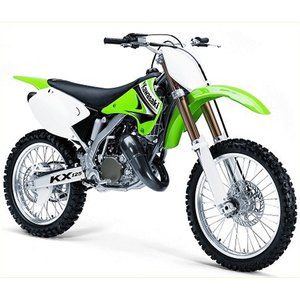Kawasaki KX 125 [2003-2008]: A Two-Stroke Motocross Legend Revisited
Introduction
The Kawasaki KX 125 remains one of the most iconic two-stroke motocross machines of the 2000s. Produced from 2003 to 2008, this generation of the KX 125 carved its reputation as a lightweight, high-revving weapon for riders who valued agility and raw power delivery. While modern four-strokes dominate today’s tracks, the KX 125’s scream still echoes in the memories of dirt bike enthusiasts. After throwing a leg over a meticulously maintained 2007 model, it’s clear why this bike retains its cult status.
Design & Ergonomics
The KX 125’s design screams purpose. Clad in Kawasaki’s signature Lime Green, the bike features a minimalist perimeter frame made of high-tensile steel paired with an aluminum subframe (from 2005 onward). At 87 kg (191.8 lbs), it feels shockingly light when lifting it off the stand – a stark contrast to today’s four-stroke counterparts.
The seat height of 945 mm (37.2 inches) suits riders between 165-183 cm (5’5” to 6’0”), though taller riders might find the cockpit slightly cramped during aggressive maneuvers. Narrow bodywork – just 815 mm (32.1 inches) at the widest point – allows for easy weight shifting mid-corner. The 8.2L (2.17 US gal) fuel tank is discreetly integrated, maintaining the bike’s slim profile.
Engine Performance: Two-Stroke Thunder
At the heart of the KX 125 lies its 124cc liquid-cooled two-stroke engine, producing 40.5-41 HP (29.6-29.9 kW) at peak RPM. The Mikuni TMX38x carburetor delivers crisp throttle response, though it demands meticulous jetting adjustments for altitude/temperature changes – a small price to pay for that addictive powerband hit.
Twist the throttle, and the engine builds power linearly until the revs climb past 7,000 RPM. Then, the power valve opens wide, unleashing a surge of acceleration that pulls hard until the 11,500 RPM redline. The 6-speed transmission shifts with a positive click, though the clutch can feel heavy during prolonged technical sections.
Torque figures of 26.5 Nm (19.5 ft.lbs) might seem modest, but the bike’s featherweight mass creates a thrilling power-to-weight ratio of 0.47 HP/kg. On hard-packed tracks, the engine shines, but in deep loam or mud, maintaining momentum requires precise clutch work – a skill this bike will quickly teach you.
Suspension & Handling
Kawasaki’s chassis geometry strikes a balance between stability and agility. The 27-degree rake and 113 mm (4.4 inches) of trail provide quick steering without headshake at speed. The 1470 mm (57.9-inch) wheelbase feels planted through rutted corners yet nimble enough for tight rhythm sections.
Front Suspension: The 48mm inverted Kayaba forks (2005-2008 models) offer 300 mm (11.8 inches) of travel with 16-way compression/rebound damping adjustments. They absorb square-edge hits confidently, though the initial stroke can feel stiff for lighter riders.
Rear Suspension: The Uni-Trak linkage system pairs with a fully adjustable shock offering 310 mm (12.2 inches) of travel. It’s progressive enough for small bump compliance yet firm during hard landings. Dialing in the sag (recommended 90-100 mm / 3.5-3.9 inches) is crucial to optimize rear traction.
Brakes & Wheels
Stopping power comes from a 240mm front disc and 190mm rear disc (2005-2008). While not as strong as modern systems, the Nissin calipers provide adequate feel for a bike this light. The 21-inch front and 19-inch rear wheels wrapped in 80/100-21 and 100/90-19 tires (respectively) offer predictable slide control, though serious riders will upgrade to modern rubber.
Competition
The KX 125 faced fierce rivals in its era:
- Yamaha YZ125: Lighter feel (84.8 kg) and broader powerband, but less mid-range punch.
- Honda CR125R: Renowned for handling but plagued by anemic engine output.
- Suzuki RM125: Aggressive steering geometry favored advanced riders.
Where the KX 125 excelled was its versatility. The Kawasaki’s suspension worked better for intermediate riders across varied terrain compared to the Yamaha’s track-focused setup. While the CR125R struggled with low-end power, the KX’s carbureted engine responded well to aftermarket pipes and reed valves – a boon for tuners.
Maintenance: Keeping the Green Machine Alive
As a two-stroke, the KX 125 is mechanically simpler than modern four-strokes, but it demands disciplined upkeep:
Engine:
- Piston Replacement: Every 20-30 hours for aggressive riders. Use quality forged pistons (Wiseco or ProX)
- Power Valve Cleaning: Degrease every 15 hours to prevent carbon buildup
- Premix Ratio: 32:1 for trail riding, 40:1 for track use (always use JASO-FD certified oil)
Suspension:
- Change fork oil every 50 hours
- Inspect linkage bearings annually; repack with waterproof grease
Carburetor:
- Clean pilot jets monthly if not ridden regularly
- Replace throttle cable every 2 seasons
MOTOPARTS.store Recommendations:
- Upgrade to a V-Force reed valve for sharper throttle response
- Install a stainless steel oil filter for easier cleaning
- Swap stock footpegs for wider aftermarket pegs (e.g., Fastway FIT System)
Conclusion
The 2003-2008 Kawasaki KX 125 remains a benchmark for two-stroke motocross purity. It rewards skilled riders with razor-sharp handling and an engine that screams defiance at the four-stroke revolution. While it lacks the torque of modern bikes, few machines deliver such a visceral connection to the raw fundamentals of motocross. For riders looking to relive the glory days of premix smoke or introduce newcomers to lightweight MX dynamics, the KX 125 is more than a relic – it’s a masterclass in analog adrenaline.



















